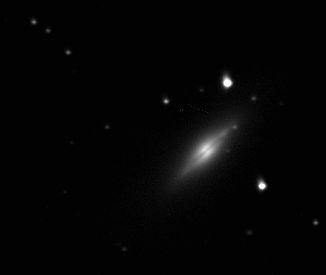

This is NCG5866 which may or may not be the object Messier included as M102 in his catalogue. It was probably first observed either by Pierre Méchain or Charles Messier in 1781, but Messier did not document object 102 in his catalogue and to this day there is some doubt as to which object his entry applies. The galaxy was rediscovered by William Herschel in 1788. It is 45 million light years away and subtends an angle of 5.3 arc minutes corresponding to a diameter of 69,000 light years.
NGC5866 is a lenticular (lens-shaped) galaxy seen almost exactly edge on, so that the dark central band is just visible in my image. It is the brightest of a group of at least ten galaxies including an edge-on spiral NGC5907. From the dynamics of this group, it has been estimated that the mass of NGC5866 is of the order of one million million solar masses making it a particularly massive galaxy.
 |
My first attempt at this faint galaxy. The galaxy barely showed over the light pollution but the Starlight Xpress capture software also includes some useful enhancement tools. These include background subtraction, which makes the background black, and a non-linear stretch, which behaves like a positive gamma correction. Use of these tools at the telescope convinced me that I could resolve the galaxy from the background and that a longer exposure would be of no help because the background was giving a significant signal. However I had to apply these tools (background, stretch, and a second background) to each frame before using K3CCDTools to align and stack them. Date and Time: 2nd April 2009 00:48 to 01:29 UT Camera: MX716 Telescope: LX200 with 0.33 focal reducer Capture: Star_mx7_usb. 20 frames, 120" exposure Pre-processing: Star_mx7_usb, background subtraction, non-linear stretch. Processing: K3CCDTools. 14 frames stacked, histogram 12-94. Post-processing: PhotoImpact. Gamma 1.5, brightness -10. |
||
Home Back to DSOs